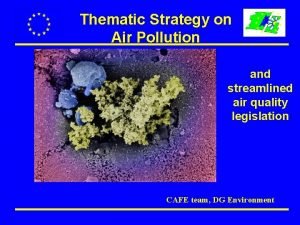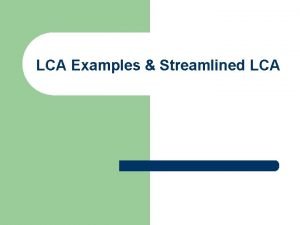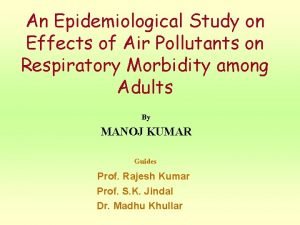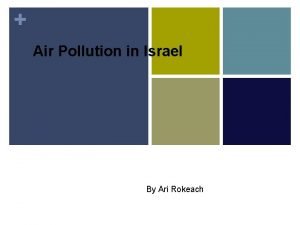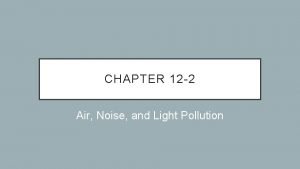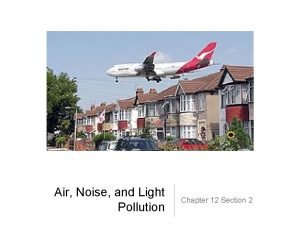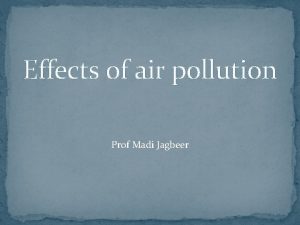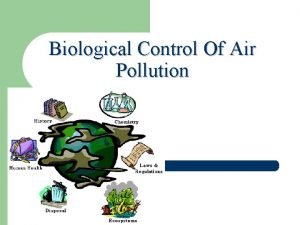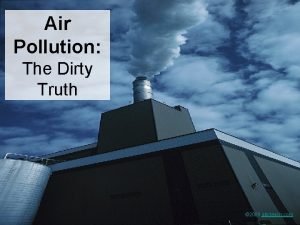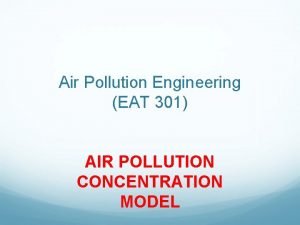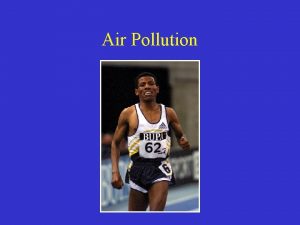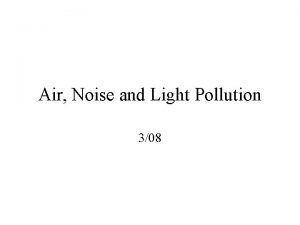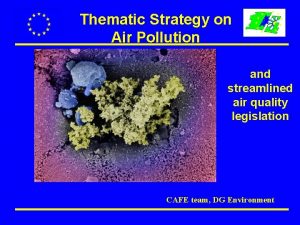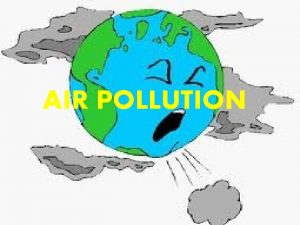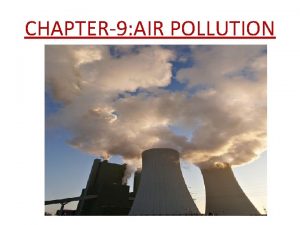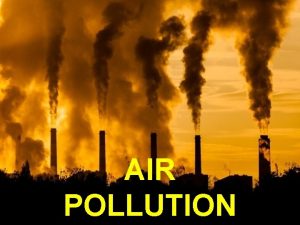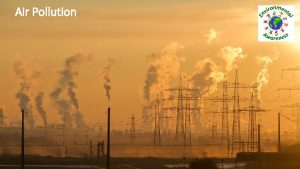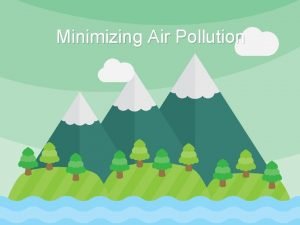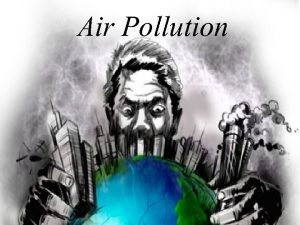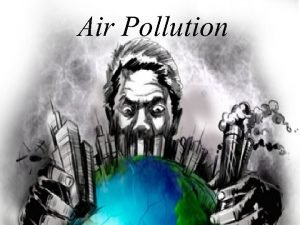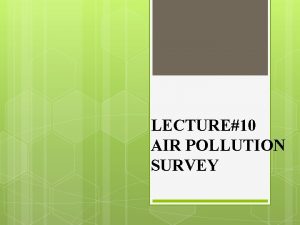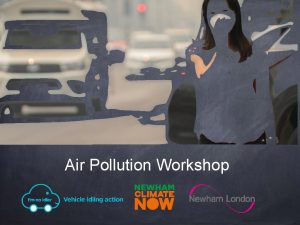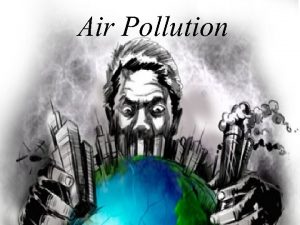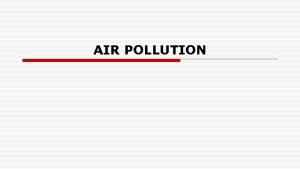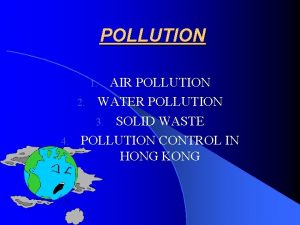Thematic Strategy on Air Pollution and streamlined air






















- Slides: 22

Thematic Strategy on Air Pollution and streamlined air quality legislation CAFE team, DG Environment

Thematic Strategy is a response to 6 th EAP • 6 th EAP- Decision of Council & EP of July 2002: • • • ‘achieving levels of air quality that do not give rise to significant negative impacts on and risks to human health and the environment’; (Art 7. 1. of 6 th EAP) Integrated approach; consistency with other environmental policies; exploit synergies; Better Regulation • supported by thorough impact assessment; • new legislative proposal to streamline air quality legislation

Objective of Clean Air for Europe (CAFE) Programme l l l Established in 2001 to provide the technical input for the Thematic Strategy on air pollution Best available science & transparency Benchmark current and future air pollution with regard to significant impacts Define interim objectives up to 2020 – based on analysis of closing the gap between business as usual and Maximum Technical Feasible improvement Inform the review of air quality legislation Starting point in 2000 m m ≈ 350, 000 premature deaths attributable to PM Average statistical life expectancy shortened by roughly 9 months, in some MSs: 1 to 2 years.

How were these interim objectives defined? l l l l Peer-reviewed health (WHO) and scientific advice Assessment of the effect of current policies Peer-reviewed integrated assessment to develop cost-effective solutions for both health and environment Peer-reviewed Cost-Benefit Analysis Macro-economic analysis m Lisbon Strategy & Competitiveness Stakeholder involvement and consultation m Over 100 stakeholder meetings and over 10. 000 responses to internet based consultation Accompanied by comprehensive impact assessment (170+ pages)

Impacts addressed by the Strategy (1) l Health: Fine Particles (PM 2. 5) & Ozone Range of problems from minor respiratory effects to premature death; also cardiovascular effects. m No known thresholds for effects m l Acid rain (SO 2, NOx, NH 3) Affects freshwaters and terrestrial ecosystems m leads to loss of flora & fauna; reduced growth of forests, leaching of toxic metals into soil solution m

Impacts addressed by the Strategy (2) l Eutrophication (NOx, NH 3) m m l Excess nutrient nitrogen causes species composition change & loss of biodiversity Also causes nutrient imbalances in plants/trees increases susceptibility to other stresses such as drought Ozone (non-health) m m Damages trees and plants including agricultural crops Damages buildings/materials

Defining cost-effective solutions is complicated PM Health SO 2 Eutrophication NH 3 NOx Acidification Interim objectives for 2020 VOC Ozone

Example 1: Fine particles Even if situation improves by 2020: 2. 5 million life years or 272, 000 premature deaths if nothing is done. Loss in average statistical life expectancy due to identified anthropogenic PM 2. 5 Calculations for 1997 meteorology Source: Clean Air for Europe Programme (2005)

Example 2: Problem of too much nitrogen deposited to nature in 2020 No EU policies have yet addressed this. Ecosystem area exceeded eutrophication 590 000 km 2 Percentage of ecosystems area with nitrogen deposition above critical loads using grid-average deposition. Calculation for 1997 meteorology Source: Clean Air for Europe Programme (2005)

Summary of “Business as Usual” l l l Emissions continue to decline But in 2020 m Premature deaths related to fine particulates still 270, 000 m Loss of statistical average life still 5 months in the EU m Ozone premature mortality equal to 20, 800 cases m 119, 000 km 2 of forest at risk from acid rain m 590, 000 km 2 of ecosystems at risk from nutrient Nitrogen m 760, 000 km 2 of forest at risk from ozone Cost-effective improvements are possible k. T 2000 2020 % SO 2 8736 2806 -68% NOx 11583 5889 -49% VOCs 10661 5918 -44% PM 2. 5 1749 971 -44% NH 3 3824 3686 -4% Ships will represent 125% and 101% of land based SO 2 and NOx emissions in 2020.

The Strategy

€ Billion / year Costs and benefits of the CAFE policy scenarios 200 Strategy costs € 7. 1 billion per annum in 2020 and thereafter 150 100 50 0 Case "A" Strategy Case "B" Case "C" Road sources costs SOX costs NOX costs Max. technical reductions NH 3 costs VOC costs PM 25 costs Health Benefits Uncertainty

Improvement of health & environment indicators following the Strategy (improvement relative to 2000)

Summary of Strategy – Costs & Benefits Human health Ambition level Costs per annum (€bn) Natural environment Life Years Lost (million) PM 2. 5 Premature deaths (000 s) PM 2. 5 and ozone Range in monetised health benefits per annum (€bn) Forests Seminatural Freshwater Ecosystem area exceeded eutrophication (000 km 2) 2000 3. 62 370 - 243 24 31 733 827 - Baseline 2020 2. 47 293 - 119 8 22 590 764 - Strategy 1. 91 230 42 – 135 63 3 19 416 699 7. 1 MTFR 1. 72 208 56 – 181 36 1 11 193 381 39. 7 Ecosystem area exceeded acidification (000 km 2) Forest area exceeded ozone (000 km 2)

Objectives of the Strategy Improvements by 2020 relative to 2000 Life Years lost from particulate matter (million) 47% Acute mortality from ozone 10% Ecosystem forest area exceeded from acidification 74% Ecosystem freshwaters area exceeded from acidification Ecosystem area exceeded from eutrophication 39% Forest area exceeded by ozone 15% 43%

Lisbon Strategy/Competitiveness • No change in jobs • GDP effects are small • -0. 01% change in growth rate billions of euros

What about China? l Has already adopted Euro 2 standard for cars m l Newly built and expanded coal-fired units must install flue gas desulphurization (FGD) m l l Old plants, sulphur content of coal below 0. 5% All pure condensing type generators below 50 MW are phased out Levy on SO 2 emissions m m l Euro 3 standard in 2007 About € 60/tonne US SO 2 price is $150 -$200/tonne Similar levy planned also on NOx emissions.

Measures following the Strategy l l Euro 5 for cars and vans Euro 6 for Heavy Duty Engines Revision of the NECD consistent with objectives identified in the Strategy Small scale combustion m m l l Ship NOx engine standards (IMO or Community) Agriculture (NH 3) m m l Review of IPPC directive for larger sources Energy using Products directive for small sources N content of feedstuffs Review of IPPC directive for intensive agriculture Revise Air quality legislation

Air Quality Legislation (1) COM (2005) 447 final l Better Regulation Merge AQ Framework Directive, Eo. I Decision, and 1 st- 3 rd Daughter directives m Tidy up inconsistencies m More flexibility for Member States m Natural Sources of pollution can be discounted r Time extensions (< 5 years) where all reasonable measures taken and new plan prepared to ensure compliance r

Air Quality Legislation (2) l l l Move towards electronic reporting of air quality information/Inspire friendly No change to existing limit values New provisions on PM 2. 5 m m m Concentration cap of 25µg/m 3 annual average to apply everywhere – legally indentical to a limit value. Robust monitoring of PM 2. 5 concentrations Target to reduce national average measured urban background concentration by 20% between 2010 and 2020 subject to later review where differentiated MS legal objectives to be proposed

New NEC Directive l l New pollutants (PPM, CH 4) New approaches – trading/cooperation between Member States Relative ceilings rather than absolute caps New obligations to support CLRTAP scientific work m m m l CLs reporting Gridded emissions reporting Monitoring Revision of the reporting regime

Final thoughts l Air pollution is and will continue to be a real problem for health and environment m l Ambitious but cost-effective proposals m m l Need to act at EU level -- air pollution is transboundary Based on comprehensive Impact Assessment Based on sound peer-reviewed science Better Regulation m m Streamlining legislation: 50% reduction in paper provisions New approach to environmental policy r r l Flexibility Reducing average background concentration of fine particulates http: //europa. eu. int/comm/environment/air/cafe/index. htm
 Air pollution
Air pollution Thematic statement definition
Thematic statement definition Hensriks
Hensriks Respax online operator reviews
Respax online operator reviews Chapter 12 section 1 what causes air pollution answers key
Chapter 12 section 1 what causes air pollution answers key Chapter 12 air section 1 what causes air pollution
Chapter 12 air section 1 what causes air pollution Land pollution effects on human health
Land pollution effects on human health Soil pollution images diagram
Soil pollution images diagram Air pollution aims and objectives
Air pollution aims and objectives Primary pollutants and secondary pollutants
Primary pollutants and secondary pollutants Ari rokeach
Ari rokeach Aim and objectives of air pollution
Aim and objectives of air pollution Section 2 air noise and light pollution
Section 2 air noise and light pollution Section 2 air noise and light pollution
Section 2 air noise and light pollution Pt tanah air sentosa
Pt tanah air sentosa Control measures of noise pollution
Control measures of noise pollution Introduction of pollution
Introduction of pollution Air pollution effects to plants
Air pollution effects to plants Air pollution contents
Air pollution contents Main cause of air pollution
Main cause of air pollution Air pollution box model example
Air pollution box model example General effects of air pollution
General effects of air pollution Air pollution consequences
Air pollution consequences
